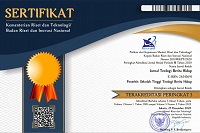Analisis Perbandingan Gramatikal-Historis Bahasa Lidah dalam 1 Korintus dan Kisah Para Rasul
DOI:
https://doi.org/10.38189/jtbh.v3i2.80Keywords:
glossolalia, speaking in tongues, 1 Corinthians, Acts, PaulAbstract
Glossolalia is currently a relevant topic. There is much controversy and debate about the practice of speaking in tongues. This paper will conduct a comparative analysis of tongues in 1 Corinthians and Acts. The practice referred to is specifically whether the Bible allows simultaneous speaking in tongues based on both books. Also regarding the speaking in tongues, whether it must be understood by others or is it necessary for someone to interpret it. This situation also occurs in the current context. Believers in some churches when in a worship (singing or praying) together speaking in tongues and without interpretation. The author finds that there are significant differences regarding the practice of speaking in tongues as instructed by Paul in 1 Corinthians and the story of speaking in tongues as written by Luke in Acts. In fact, there is an interpretive vacuum that contemporary interpreters must fill. The author uses a comparative method and a grammatical-historical hermeneutic approach to the biblical text.
References
Boiliu, Ibrahim, Aeron Frior Sihombing, Christina M Samosir, and Fredy Simanjuntak. “Mengajarkan Pendidikan Karakter Melalui Matius 5 : 6-12.†KURIOS (Jurnal Teologi Dan Pendidikan Agama Kristen), 2020.
Budiselić, Ervin. “Glossolalia: Why Christians Can Speak in Tongues in a Church Service without Interpretation.†Kairos, 2016.
Butler, Jon, Grant Wacker, and Randall Balmer. Religion in American Life: A Short History. Oxford: Oxford University Press, 2008.
Cooper-Rompato, Christine F. The Gift of Tongues: Women’s Xenoglossia in the Later Middle Ages. Pennsylvania: Pennsylvania State University Press, 2010.
Faupel, William D. “Glossolalia as Foreign Language: An Investigation of the Early Twentieth-Century Pentecostal Claim.†Wesleyan Theological Journal 31, no. 1 (1996): 95–109.
Fee, Gordon. God’s Empowering Presence. Massachusetts: Hendrickson Publishers, 1994.
Fu, Timotius. “Bahasa Roh Menurut Calvin Dan Implikasinya Bagi Gereja Masa Kini.†Veritas : Jurnal Teologi Dan Pelayanan 10, no. 1 (April 1, 2009): 59–71. https://doi.org/10.36421/veritas.v10i1.210.
Green, Michael. I Believe in the Holy Spirit. Grand Rapids: Eerdmans, 1976.
Hakh, Samuel Benyamin. Perjanjian Baru: Sejarah, Pengantar Dan Pokok-Pokok Teologisnya. Bandung: Bina Media Informasi, 2010.
Hiu, Elim. Regulations Concerning Tongues and Prophecy in 1 Corinthians 14.26-40. London: T&T Clark, 2010.
Layantara, Jessica Novia. “Beyond the Language: Sebuah Studi Analisis Dan Komparasi Antara Konsep Bahasa Roh Dalam Teologi Pentakosta Dengan Konsep Rede Dalam Filsafat Martin Heidegger.†DUNAMIS: Jurnal Teologi Dan Pendidikan Kristiani 4, no. 1 (October 25, 2019): 75–98. https://doi.org/10.30648/dun.v4i1.207.
Menzies, Robert P. “Paul and the Universality of Tongues: A Response to Max Turner.†Asian Journal of Pentacostal Studies 2, no. 2 (1999): 283–95.
Moore, Mark. Fanning the Flame: Probing the Issues in Acts. Missouri: College Press Publishing, 2003.
Nazir, Moh. “Metode Penelitian, Ghalia Indonesia.†Nuraini R, EKa, 2005.
Nel, Marius. “Pentecostals and the Marginalised: A Historical Survey of the Early Pentecostal Movement’s Predilection for the Marginalised.†HTS Teologiese Studies / Theological Studies 75, no. 1 (January 30, 2019): 1–8. https://doi.org/10.4102/hts.v75i1.5184.
Ogan, Nathan. Glossolalia: The Gift of Tongues. Raleigh: Lulu Publisher, 2015.
Poythress, Vern S. “Linguistic and Sociological Analyses of Modern Tongues-Speaking: Their Contributions and Limitations.†Westminster Theological Journal, 1976.
Putrawan, Bobby Kurnia. “PENGANTAR TEOLOGI PENTAKOSTA (INTRODUCTION TO PENTECOSTAL THEOLOGY).†QUAERENS: Journal of Theology and Christianity Studies 1, no. 1 (2019): 1–7. https://doi.org/https://doi.org/10.46362/quaerens.v1i1.2.
Richardson, William. “Liturgical Order and Glossolalia in I Corinthians 14. 26c–33a.†New Testament Studies 32, no. 1 (January 5, 1986): 144–53. https://doi.org/10.1017/S0028688500013564.
Schlink, Basilea. Hidup Yang Dikuasai Roh. Malang: Gandum Mas, 2019.
Sihombing, Aeron Frior. “Latar Belakang ‘Perintah Diam’ Oleh Paulus Bagi Perempuan Dalam 1 Korintus 14:34-25.†TE DEUM (Jurnal Teologi Dan Pengembangan Pelayanan) 7, no. 2 (2018): 125–44.
Sitanggang, Murni Hermawaty. “Bahasa Lidah Dalam Ibadah Bersama Berdasarkan I Korintus 14.†DUNAMIS: Jurnal Penelitian Teologi Dan Pendidikan Kristiani, 2017. https://doi.org/10.30648/dun.v2i1.127.
Suanglangi, Hermanto. “Bahasa Roh: Apa Dan Bagaimana?†Jurnal Jaffray 2, no. 1 (April 1, 2005): 17. https://doi.org/10.25278/jj71.v2i1.146.
Turner, Max. “A Response to the Responses of Menzies and Chan.†Asian Journal of Pentacostal Studies 2, no. 2 (1999): 297–308.
Verdianto, Yohanes. “Hermeneutika Alkitab Dalam Sejarah: Prinsip Penafsiran Alkitab Dari Masa Ke Masa.†Mitra Sriwijaya: Jurnal Teologi Dan Pendidikan Kristen, 2020. https://doi.org/10.46974/ms.v1i1.2.
Wagey, Robert Calvin. “Karunia Roh Menurut Pengajaran Rasul Paulus: Suatu Kajian Teologis Terhadap Pandangan Neo-Pentakosta Tentang Karunia Spektakular.†Missio Ecclesiae Jurnal Theologia, Misiologia, Dan Gereja, 2012.
Williams, Rodman. Renewal Theology, Vol. 2, Salvation, the Holy Spirit, and Christian Living. Grand Rapids: Zondervan Publishing, 1996.


.jpg)







